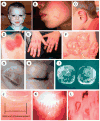Advances in Juvenile Dermatomyositis: Myositis Specific Antibodies Aid in Understanding Disease Heterogeneity
- PMID: 29576174
- PMCID: PMC5881602
- DOI: 10.1016/j.jpeds.2017.12.053
Advances in Juvenile Dermatomyositis: Myositis Specific Antibodies Aid in Understanding Disease Heterogeneity
Keywords: pathophysiology; physical signs; treatment.
Conflict of interest statement
The authors declare no conflicts of interest.
Figures


References
-
- Feldman BM, Reed AM, Rider LG, Pachman LM. Juvenile dermatomyositis and other idiopathic inflammatory myopathies of childhood. Lancet. 2008;371:2201–12. - PubMed
-
- Mendez EP, Lipton R, Ramsey-Goldman, Roettcher P, Bowyer S, Dyer A, et al. Us Incidence of Juvenile Dermatomyositis, 1995–1998: Results from the National Institute of Arthritis and Musculoskeletal and Skin Diseases Registry. Arthritis Rheum. 2003;49:300–305. - PubMed
-
- Pachman LM, Abbott K, Sinacore JM, Amoruso L, Dyer A, Lipton R, et al. Duration of illness is an important variable for untreated children with juvenile dermatomyositis. J Pediatr. 2006;148:247–53. - PubMed
Publication types
MeSH terms
Substances
Grants and funding
LinkOut - more resources
Full Text Sources
Other Literature Sources

